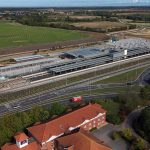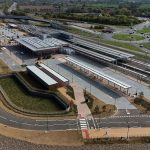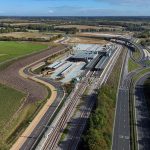THE JOURNEY TO BEAULIEU
I am delighted and proud to see that the new Beaulieu Station is to open on Sunday, 26 October. This is a project that I have dedicated much of my planning career to making a success and I reflect on the many challenges and obstacles that we overcame to deliver. It is the first new station on the Great Eastern Main Line in over 100 years. It has been a long journey.
Congratulations to all who contributed to the realisation of this major new infrastructure asset for Chelmsford. However, the one person who should be honoured for inspiring and starting the journey is the late Alan Cherry CBE DL FRICS Hon MRTPI, who sadly died in 2010. During his half century at the helm of the company he founded, Countryside Properties, he created one of the UK’s leading and most respected housing and property companies specialising in the erection of sustainable communities and urban regeneration. The vision for Beaulieu and the new railway station is his. Without Alan’s experience, vision, drive and tenacity this station would not have happened, and certainly not at the present time. This article is a tribute to Alan for everything he did towards realising the potential of Chelmsford.
The starting point was that having successfully delivered Chelmer Village, Alan was contemplating where Chelmsford could potentially meet its future housing and employment needs. Having worked closely together on the planning of Church Langley in Harlow, Great Ashby in Stevenage and Great Notley Garden Village, Alan asked for my opinion on the potential future growth options for Chelmsford. Following a detailed ‘sieve map’ analysis and comparative assessment of various alternatives it was concluded that the area of North East Chelmsford in proximity to the main line railway and A12/A130 junction was the preferred opportunity area with scope to build a new sustainable mixed-use community. Alan considered that with Chelmsford’s reputation and success in establishing a strong economic base, including world class electronics and defence technology, there was a great opportunity to develop a hi-tech version of Stockley Park in West London for the County Town and mid-Essex. Together with a wide mix of high-quality housing in a landscaped setting, it would become an attractive location for successful expanding and ‘footloose’ companies. However, a new railway station was essential in order to tempt such firms to locate to Chelmsford.
There had been previous ideas mooted to create a halt at NE Springfield for freight and transport of minerals, but not a new station that would also relieve congestion at the existing town centre station.
With the support of landowners, Alan commissioned a team of consultants, including myself as planning and master planning lead, to advise on the full range of key considerations and inputs to prepare a masterplan and vision for the area. These included Derek Lovejoy and Partners as Landscape Architects, Anthony Blee of Basil Spence & Partners on heritage and architecture, Denis Wilson & Partners as transport planners and many others on various other topics. Under Alan’s leadership, we all worked with him to formulate the initial masterplan for discussion with the County Council, Chelmsford Borough Council and key stakeholders.
One of the key challenges was to devise a scheme that had sufficient economies of scale to fund and deliver the station and other major infrastructure, but also integrated the listed Grade I and Registered Park and Garden of New Hall without causing unacceptable harm. This was addressed in the masterplan by proposing large scale compensatory landscaping to enhance the setting and create new viewpoints to appreciate the former Tudor palace. Much of the historic setting of New Hall had been spoilt over years by new major highways to the south, and to the north by pylons, mineral workings and new buildings required by the school. There were no obvious signs of the original deer park that was located predominantly to the north of the palace. To enhance the setting of the main façade, the masterplan proposed a major parkland to the south towards the railway that was intended to be reminiscent of a Tudor deer park together with a series of green links integrating new development with the wider countryside.
A new state-of-the-art business park for Chelmsford, similar to ’Stockley Park’ near Heathrow, including a new railway station, was proposed to the east of General’s Lane and a potential new northern bypass, where it would not be viewed from New Hall.
Unfortunately, Alan’s ideas and proposals were far too visionary and ambitious for the two Authorities concerned in the late 1980s and 1990s. Although Countryside Properties promoted the scheme for Greater Beaulieu Park to be allocated in the emerging first Borough Local Plan, it was omitted by the Council. The first breakthrough came about because the Local Plan Inspector concluded that there should be an allocation for approximately 400 dwellings to the east of White Hart Lane. This was subsequently the subject of a series of successful planning applications that became what is now called ‘Beaulieu Park.’
The second and most significant breakthrough came about following a change in direction at the Borough Council from around 2003, plus Network Rail’s endorsement in 2004, meant that the principle of the new station was established. It was then a matter of how to deliver it.
By 2008 Chelmsford had been identified in the Approved East of England Plan (EE)) as a ‘key centre for development and change’, with the potential to develop as a significant growth focus for central Essex and as a ‘regional transport node’: the Councils should work with developers and other agencies to secure enhancement, effective management and appropriate use of land in the urban fringe. It also proposed that employment sites of quality and quantity should be provided at specified strategic locations, including Chelmsford. The employment base should be increased and diversified. With regard to transport, it stated that growth must assist the development of more sustainable transport systems within the town and improve on its strategic links to London.
The EEP set the focus of the new Chelmsford Core Strategy in 2008 which established the strategic location for two new neighbourhoods to the north of Chelmsford, one of which was at north-east Springfield. This included the integration of major new transport infrastructure including the new station as part of the overall development.
I acted to promote, prepare and present evidence to the Inspector examining the submitted Core Strategy that the proposed scale of the Beaulieu Park scheme was essential to demonstrate a viable technical and business case to deliver the station and other major transport infrastructure. In this regard, great credit must be given to Ian Mitchell of Mayer Brown Transport Planning Consultants, who undertook the work and collaborated with Network Rail and Essex County Council to satisfy the Inspector. This work was subsequently updated and refined during the preparation, submission and consideration of the outline planning applications for the railway station and Beaulieu Park submitted in 2009, that were granted in May 2013 and March 2014, respectively.
Very sadly, Alan Cherry is no longer with us to see that his vision and foresight would become a reality.
The overall journey and timetable to arrival at Beaulieu Station is as follows:
1986
North East Chelmsford identified in a strategic growth study as a sustainable location for major mixed use development served by a multi-modal transport interchange with a new station at the A12/A130 interchange and new NE Chelmsford by-pass.
1987
Countryside Properties agree terms to promote land at New Hall, Old Lodge Farm, Belstead Hall Farm and Bulls Lodge, collectively renamed Beaulieu Park as a tribute to Henry VIII’s renaming of New Hall as the Palace of Beaulieu.
1987-1990
Beaulieu Park masterplanned and promoted through early stages of emerging new Local Development Framework for Chelmsford as a new sustainable community with new high-tech business park and commercial uses focussed on a new station and major regional transport interchange.
1987-2005
Beaulieu Park promoted through the then emerging Chelmsford Local Plan. The proposals were omitted by the Borough Council in the draft Plan, but following a Local Plan Inquiry the Inspector agreed that land to the east of White Hart Lane should be allocated for housing. A series of planning permissions in the 1990s delivered around 650 homes, open space and sports facilities, known at the time as ‘Lesser Beaulieu Park’. This effectively became Phase 1 of Beaulieu.
2005-2008
Beaulieu Park promoted through various stages of the emerging Chelmsford Core Strategy. The Core Strategy (CS) established the principle of development of two new neighbourhoods to the North of Chelmsford, one of which was at north-east Springfield. This included the integration of major transport infrastructure, including the new station, as part of the overall development. As part of the justification for the Beaulieu Park scheme, evidence was presented to the Inspector that the station and major infrastructure was viable and deliverable.
2008-2009
Two planning applications with EIAs prepared and submitted by Andrew Martin Associates for Countryside Zest for a new neighbourhood and railway station to run in parallel with the emerging North Chelmsford Area Action Plan (NCAAP).
2008-2010
The NCAAP set out the development framework for NE Chelmsford including the allocation of the new neighbourhood proposed as Beaulieu Park, together with the strategic infrastructure including the station.
2012
Following refinements to the proposals during engagement with key stakeholders and public consultation, the planning applications/EIAs were revised.
2013
28th May 2013 outline planning permission granted for the new station and related development.
2014
7th March 2014 outline planning permission granted for the new neighbourhood of Beaulieu Park for up to 3,600 dwellings, 62,300 sqm mixed uses, education, neighbourhood centre, open space and associated development.
2016
Further options agreed by Countryside Zest to promote strategic growth of land at Boreham Airfield, Bulls Lodge Quarry and Park Farm to form part of the Chelmsford Garden Community.
2018-2020
Preparation and submission of evidence to emerging Chelmsford Local Plan to support the allocation of the Chelmsford Garden Community, as proposed in the Local Plan adopted in 2020.
2022
22nd June 2022 Approval of application by Network Rail for Reserved Matters and discharge of conditions of 2013 outline consent.
2023
March – Construction commences on the new station.
2025
26th October – station scheduled to open.
JOURNEY TIME = 39 YEARS
Article written by: Andrew Martin MAUD DipTP(Distinction) FRICS FRTPI
(c) Andrew Martin – Planning Limited 2025




